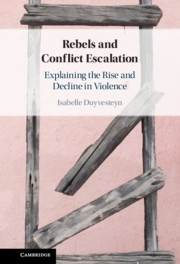Book contents
- Rebels and Conflict Escalation
- Rebels and Conflict Escalation
- Copyright page
- Dedication
- Contents
- Tables
- Vignettes
- Preface and Acknowledgements
- Abbreviations
- 1 Rebels and Escalation
- 2 Escalation and De-Escalation
- 3 Political Opportunity and Rebel Violence
- 4 Political Will
- 5 Capabilities
- 6 Capabilities
- 7 Political Will
- 8 Legitimacy and Support
- 9 De-Escalation
- 10 The Escalation and De-Escalation of Rebel Violence
- References
- Index
9 - De-Escalation
Published online by Cambridge University Press: 01 July 2021
- Rebels and Conflict Escalation
- Rebels and Conflict Escalation
- Copyright page
- Dedication
- Contents
- Tables
- Vignettes
- Preface and Acknowledgements
- Abbreviations
- 1 Rebels and Escalation
- 2 Escalation and De-Escalation
- 3 Political Opportunity and Rebel Violence
- 4 Political Will
- 5 Capabilities
- 6 Capabilities
- 7 Political Will
- 8 Legitimacy and Support
- 9 De-Escalation
- 10 The Escalation and De-Escalation of Rebel Violence
- References
- Index
Summary
In chapter nine the focus is entirely on de-escalation, which compared to the discussion about escalation, is rather under-theorised presently. The starting point form the Cold War ideas on how conflict is supposed to de-escalate, followed by a treatment of the literature on the restraints of terrorism and insurgency whether self-imposed or not. Two hypotheses related to de-escalation are formulated based on the literature about de-legitimation and norm convergence and about an inability shift to continue the conflict, in the shape of a loss of foreign support and defection. The vignette in this chapter is the Chechen independence movement.
- Type
- Chapter
- Information
- Rebels and Conflict EscalationExplaining the Rise and Decline in Violence, pp. 174 - 188Publisher: Cambridge University PressPrint publication year: 2021

